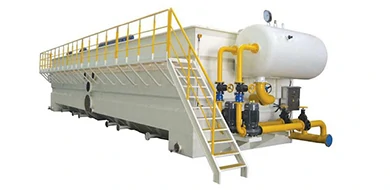
Flotation is a general method used in water treatment to liquid solid separation. The general process involves the flotation of particles to the surface of the liquid where they are concentrated and removed by physical means. Dissolved Air Flotation (DAF) is an efficient flotation method for water clarification. The term refers to the method of producing flotation by dissolving air in the water under pressure and then releasing the pressure. When the pressure is released the solution becomes supersaturated with air as millions of small bubbles form. These bubbles attach to any particles in the water causing their density to become less than that of water. The particles then rapidly float to the surface for collection and removal, leaving the clarified water behind.
Specific Advantages
Most modern flotation units can process from 3 to 12 US gallons per minute per square foot ofavailable clarifier surface area. Conventional sedimentation clarifiers typically only process 1-2 gpm/sq. ft; DAF clarifies more water given the same area as settling. Flotation clarifiers can operate with as little as 16" of depth with a retention time of 2-4 minutes. Sedimentation requires approximately 80 inches of depth and a retention time of 60-100 minutes. DAF operates with 1/4 the time and 20 times faster than settling. This allows for much smaller and more economical DAF units to be designed, saving construction and installation costs. By selecting DAF over settling the following specific advantages are realised:
- Initial construction costs are reduced 30-50% as compact DAF clarifiers are less costly to construct and install than larger settling basins.
- Further savings are achieved when the plant is enclosed in a building as less area is required for DAF.
- Chemical costs are reduced as flotation in general requires less chemical pretreatment to form a light, small floc.
- DAF is ideal for treatment plants in remote locations or with limited available area.
- Low retention time
- Low Space requirement
- Excellent solution for high flowrate
- High clarification efficiency
- Epoxy Coated Mild Steel
- Anti-corrosion Treatment
- FRP Lamella Plates
- Equal Flow Distribution
- Consistent Laminar Flow
- Durable and Compact
Bench scale test comparison between DAF and settling. After 1 minute the DAF treated solids are already beginning to collect on the water surface; note the clarified water layer at the bottom of the cylinder. After 3 minutes all the suspended solids in the DAF sample have been floated to the surface in a concentrated layer, leaving clarified water underneath. The sedimentation sample on the left is still turbid.
Basic Reqirements
Each DAF system requires a means of generating the dissolved air and a vessle to process the flow. Dissolved air is typically produced in a pressure tank, tube or special pump depending on the equipment manufacturer. Bubbles in the 30-60 micron range produce the best flotation of solids.
The DAF vessle can be rectangular, circular, or cylindrical and contain incline plates or other flotation enhancing devices. An important criteria in any design is the minimization of turbulence due to water flow which can hinder the flotation of solids.
Advantages
Product Description